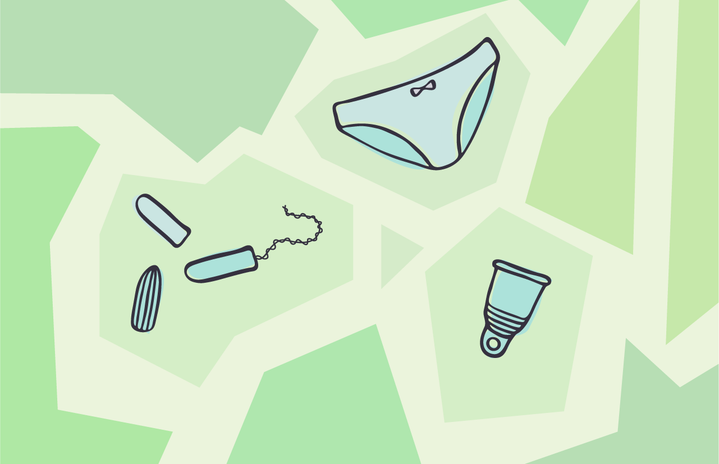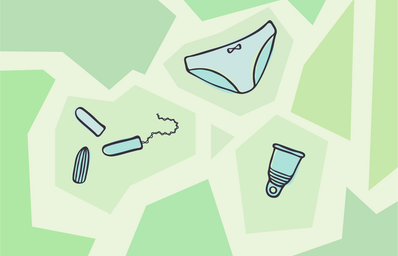Let’s face it. That time of the month is painful enough without having to worry about anything else (except chocolate and cliché movies), but have you ever thought about what your go-to period products are made of?
Though it is required for companies to provide a list of ingredients for most ingestible products, feminine hygiene products, including tampons and period pads, aren’t held to the same standard. Unfortunately, the lack of a thorough regulation in the feminine care industry poses an inevitable threat for consumers’ health.
While menstrual pads rarely come with information about their composition, tampons tend to disclose that they “‘may’ contain cotton or rayon or polyester, or possibly a combination of them.” Generally speaking, regular period products “are made out of rayon and/or non-organic cotton and bleached with chlorine, whereas organic sanitary products are made from 100% organic cotton and bleached with peroxide.”
Although the FDA does recommend that tampons be free of dioxin, a group of cancerous chemicals that are highly toxic, and that companies identify the bleaching process behind feminine sanitary products, toxic unregulated chemicals could still be present in our sanitary products.
If I haven’t convinced you yet, let’s take a look at other ways that single-use period products are ruining our lives, literally. In the book Flow: the Cultural Story of Menstruation, Susan Kim mentions that on average, a person that menstruates produces from 250 to 300 pounds of trash in a lifetime.
Additionally, according to The Leaf Score, nearly “20 billion sanitary napkins, tampons and applicators are sent to landfills every year.”
Though a bit dated, The Ocean Conservancy’s findings of their 2004 International Coastal Cleanup are still alarming: nearly 18,000 pounds of tampons and tampon applicators were collected in a single day. The environmental impact of periods, however, does not end there.
Unfortunately, tampons are not biodegradable and it is extremely probable for these to end up in sewer systems and waterways when they are flushed. Consequently, these may also end up on our beaches.
Even though you can reduce your ecological footprint by buying more items in bulk or applicator-free tampons, using period products that are less harmful for the environment, as well as yourself, could be a safer (and cheaper) route.
If you’re looking for non-toxic and planet-friendly menstrual products, here are five alternatives (paired with my unsolicited opinions) to say hello to the best period you’ll ever have.
- The menstrual cup
-
If you’ve heard of menstrual cups, you probably know that they are the superstar product in the feminine care industry. Menstrual cup shape, size and composition may vary.
Essentially, however, they work the same way: after it is inserted in your body, it stays there and collects the blood. When you consider it appropriate (this depends on the heaviness of your flow and personal preference), you remove it from your body, wash it, and reinsert it.
Though it depends on your menstrual flow and the fit of the cup in your body, menstrual cups may last for up to 12 hours. Luckily, menstrual cups are reusable and quite flexible. The cups’ lifespan may be within the range of 6 months and 10 years if taken care of properly.
If you have no idea which style and brand to buy, taking the cup quiz might help!
My two cents: Don’t give up after the first cycle in which you use them. Give it another try and keep in mind that you may have bought one that is not the most appropriate for your body or flow. If your problem has to do with inserting or removing the cup, there are plenty of informative videos available.
- Reusable and washable cloth pads
-
Reusable cloth pads work almost the same way as traditional menstrual pads. The only differences are that you are able to reuse them and that you have to wash them.
Similar to menstrual cups, the fabric, size, absorbance and style of the cloth pads can also vary. Cloth pads have a waterproof outer lining that prevents leaks. Just like disposable menstrual pads, reusable pads are placed externally and over your underwear.
To clean and care for the pads, you may have to follow specific instructions according to their manufacturer. Prior to buying your first ones, you may try taking a look at online reviews.
My two cents: It is a better alternative for those who may find the menstrual cup to be uncomfortable. Though it may be fun to explore with different patterns, colors and styles, if hand-washing is the only option to clean your reusable pads, it may take a lot of effort when compared to other methods.
Particularly, removing stains is a difficult task to accomplish on multiple occasions while you are on your period. I consider it best to combine the menstrual cup with the reusable pad to prevent leaking and reduce the amount of work related to cleaning a cloth pad.
- Period panties
-
Imagine only having to wear panties during your period. Sounds unreal, but period panties make it possible. They are basically the same as normal underwear, except that they have a waterproof layer that prevents leaks and absorbs blood.
Here’s a list of the best period panties to make your dreams come true.
My two cents: I love the way they look. However, they are quite expensive when compared to the cup or cloth pads. It’s a cool option that some period panties can be cleaned using a washing machine.
For me, a reusable cloth pad is a better and cheaper option instead of period panties. However, it’s slightly more comfortable to only have the period panty as opposed to wearing a reusable pad on top of normal underwear.
- Reusable natural sponges
-
As weird as it may sound, period sponges are inserted in the vagina to absorb menstrual blood.
On the contrary to other period products that are inserted in the vagina, reusable sponges conform to the shape of the body. That is, they are notably malleable. Though there are synthetic, single-use or even pre-lubricated sponges, I recommend using natural sponges, which are unlike any other man-made period product. Jade and Pearl offers both synthetic and natural period sponges.
Natural sponges may last from 3 to 6 months. These sponges can be bleached or unbleached, depending on personal preference. The cleaning is more sensitive than other methods as strong chemicals can damage the sponges.
Some sponges can also be used during sexual intercourse. For a more detailed day-to-day description of a sponge use experience, read Mashable’s article.
My two cents: I’d love to try them and even though I’m relatively open to alternative products, I find the idea of wearing sponges inside me kind of weird. Let’s hope I build up the courage to try them in 2021!
- Menstrual discs
-
Menstrual discs are very similar to menstrual cups with regards to being inserted in the vagina and to the way they collect fluids. However, how they are worn and designed is quite different.
According to Put a Cup in It, “the cup sits in the vaginal canal below the cervix” while “a disc sits back into the vaginal fornix behind and below the cervix.” Generally speaking, cups can be folded in many different ways for insertion. On the other hand, discs are inserted “by squeezing the sides together so it can be inserted lengthwise.”
For this reason, removing the discs might be harder compared to the cup.
Though there are reusable discs made of silicone or other materials, discs are known to be disposable, single-use products, which doesn’t qualify them as a green option. Companies like Flex produce single-use menstrual discs that may supposedly allow mess-free period sexual intercourse. However, some users have reported leakages during sexual intercourse.
My two cents: I’m a cup fan. I find menstrual discs to be more complex to use and since they have the same function in generally similar ways, I’d use the cup over the disk anytime.
Though green feminine products may reduce the environmental and health risks associated with single-use period products, they are certainly not exempt from drawbacks. Regardless, if you do decide to make the switch, our planet, your pocket, and your health will thank you dearly.

